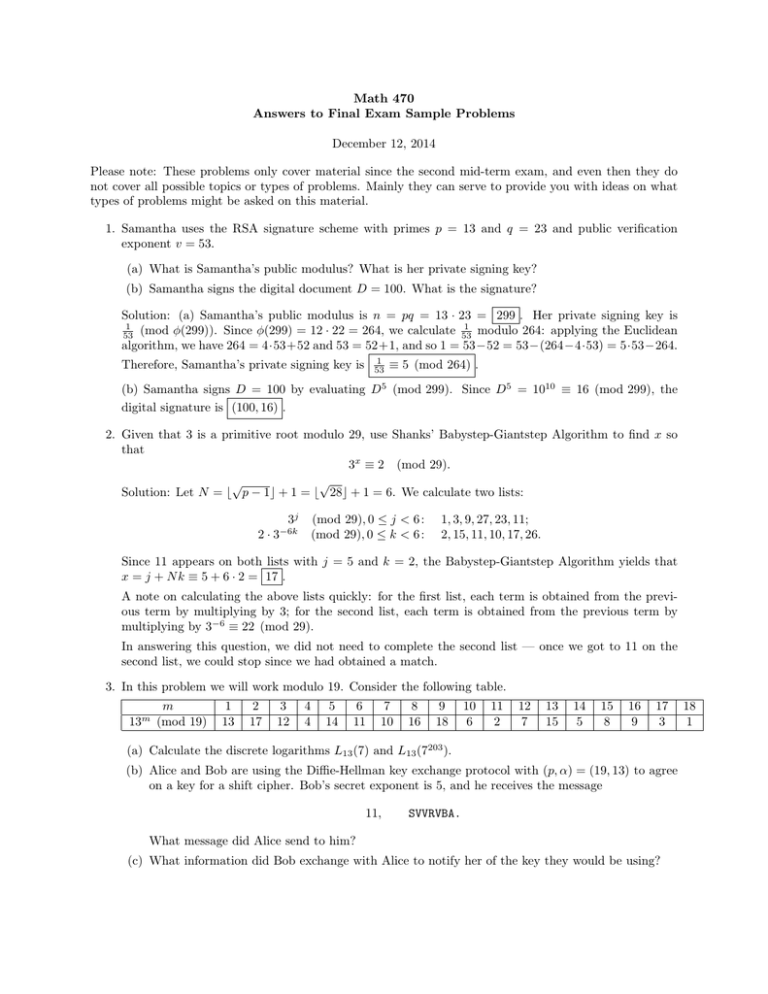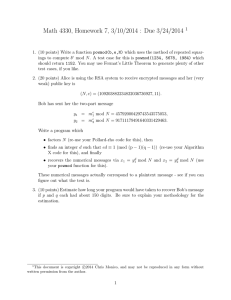Math 470 Answers to Final Exam Sample Problems December 12, 2014
advertisement

Math 470
Answers to Final Exam Sample Problems
December 12, 2014
Please note: These problems only cover material since the second mid-term exam, and even then they do
not cover all possible topics or types of problems. Mainly they can serve to provide you with ideas on what
types of problems might be asked on this material.
1. Samantha uses the RSA signature scheme with primes p = 13 and q = 23 and public verification
exponent v = 53.
(a) What is Samantha’s public modulus? What is her private signing key?
(b) Samantha signs the digital document D = 100. What is the signature?
Solution: (a) Samantha’s public modulus is n = pq = 13 · 23 = 299 . Her private signing key is
1
1
53 (mod φ(299)). Since φ(299) = 12 · 22 = 264, we calculate 53 modulo 264: applying the Euclidean
algorithm, we have 264 = 4·53+52 and 53 = 52+1, and so 1 = 53−52 = 53−(264−4·53) = 5·53−264.
1
53
Therefore, Samantha’s private signing key is
≡ 5 (mod 264) .
(b) Samantha signs D = 100 by evaluating D5 (mod 299). Since D5 = 1010 ≡ 16 (mod 299), the
digital signature is (100, 16) .
2. Given that 3 is a primitive root modulo 29, use Shanks’ Babystep-Giantstep Algorithm to find x so
that
3x ≡ 2 (mod 29).
√
√
Solution: Let N = b p − 1c + 1 = b 28c + 1 = 6. We calculate two lists:
3j
(mod 29), 0 ≤ j < 6 :
(mod 29), 0 ≤ k < 6 :
−6k
2·3
1, 3, 9, 27, 23, 11;
2, 15, 11, 10, 17, 26.
Since 11 appears on both lists with j = 5 and k = 2, the Babystep-Giantstep Algorithm yields that
x = j + N k ≡ 5 + 6 · 2 = 17 .
A note on calculating the above lists quickly: for the first list, each term is obtained from the previous term by multiplying by 3; for the second list, each term is obtained from the previous term by
multiplying by 3−6 ≡ 22 (mod 29).
In answering this question, we did not need to complete the second list — once we got to 11 on the
second list, we could stop since we had obtained a match.
3. In this problem we will work modulo 19. Consider the following table.
m
13m (mod 19)
1
13
2
17
3
12
4
4
5
14
6
11
7
10
8
16
9
18
10
6
11
2
12
7
13
15
14
5
15
8
16
9
17
3
(a) Calculate the discrete logarithms L13 (7) and L13 (7203 ).
(b) Alice and Bob are using the Diffie-Hellman key exchange protocol with (p, α) = (19, 13) to agree
on a key for a shift cipher. Bob’s secret exponent is 5, and he receives the message
11,
SVVRVBA.
What message did Alice send to him?
(c) What information did Bob exchange with Alice to notify her of the key they would be using?
18
1
Solution: (a) From the table we see that L13 (7) = 12 . Therefore L13 (7203 ) ≡ 203 · L13 (7) (mod 18),
and so L13 (7203 ) ≡ 203 · 12 ≡ 6 (mod 18).
(b) The first part of the message is used to obtain the key for the shift cipher. Bob finds the key
by calculating K ≡ 115 ≡ 7 (mod 19). Bob shifts SVVRVBA by −7 decrypt and finds the decrypted
message LOOKOUT .
(c) Bob would exchange 135 ≡ 14 with Alice to let her know what key they were agreeing to.
4. Suppose p is a large prime and α is a primitive root for p. For m ∈ Z, define h(m) = αm (mod p).
(a) Explain how h is pre-image resistant.
(b) Show that h is not strongly collision-free by finding a counterexample.
Solution: (a) To show that h is pre-image resistant, we need to show that for a given y ∈ {1, 2, . . . , p−1},
it is difficult to find m ∈ Z such that h(m) = y. Now finding such an m is equivalent to solving the
congruence
αm ≡ y (mod p).
In other words, finding m is equivalent to the Discrete Logarithm Problem modulo p, which is computationaly infeasible for large p.
(b) For numbers m1 , m2 , we know that
m1 ≡ m2 (mod p − 1) =⇒ αm1 ≡ αm2 (mod p) =⇒ h(m1 ) = h(m2 ).
Therefore, since we can easily pick two distinct numbers m1 and m2 with m1 ≡ m2 (mod p − 1), in
which case h(m1 ) = h(m2 ), it follows that it is easy to find collisions for h.
5. Alice is signing a document using the ElGamal signature scheme. She is using p = 23 and α = 5. She
chooses a = 9 for her private exponent.
(a) What is Alice’s public key?
(b) Demonstrate how Alice signs the document D = 10. Be specific.
(c) How does Bob verify that Alice has signed the document?
Solution: (a) Much like in 3(a), Alice’s public key is (p, α, β) with β ≡ αa (mod p). Since αa ≡ 59 ≡ 11
(mod 23). Therefore, her public key is (p, α, β) = (23, 5, 11) .
(b) Alice selects a secret number k, with 2 ≤ k ≤ p − 1 and gcd(k, p − 1) = 1. Suppose she selects
k = 7. She computes
r ≡ αk ≡ 57 ≡ 17 (mod 23),
and she computes
s≡
1
(D − ar) ≡ 19(10 − 9 · 17) ≡ 11
k
(mod 22).
The signed document is then (D, r, s) = (10, 17, 11) .
(c) Bob uses Alice’s public key to compute
v1 ≡ β r · rs ≡ 1117 · 1711 ≡ 9
(mod 23)
and
v2 ≡ αD ≡ 510 ≡ 9
(mod 23).
Since v1 ≡ v2 (mod 23), Bob concludes that Alice’s signature is valid.
6. Using our coin flipping protocol, Alice selects n = 35, and then Bob chooses x0 = 11.
(a) What is the number y that Bob sends to Alice?
(b) Alice computes the four solutions to x2 ≡ y (mod 35). What are they?
(c) Alice chooes the smallest of the solutions in (b) and sends it to Bob. Who does Bob declare as
the winner, and why?
Solution: (a) y ≡ x20 (mod 35), so y ≡ 112 ≡ 16 (mod 35).
(b) Alice sees that y ≡ 1 (mod 5) and y ≡ 2 (mod 7), so she wants to solve simultaneously x2 ≡ 1
(mod 5) and x2 ≡ 2 (mod 7). By inspection, we see that
x ≡ ±1
(mod 5),
x ≡ ±3
(mod 7).
Using the Chinese Remainder Theorem, we find that x ≡ ±4 (mod 35) and x ≡ ±11 (mod 35) .
(c) Alice sends 4 back to Bob. Since 4 6≡ ±11 (mod 35), Bob wins .







